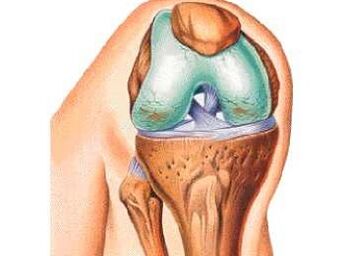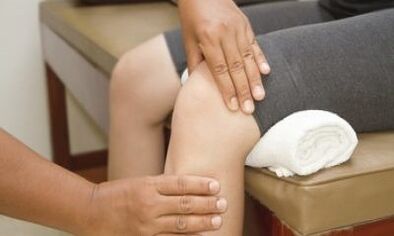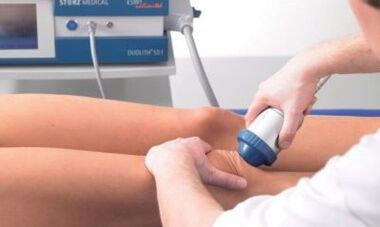Artosis or osteoarthritis of the knee joint is a disease that occurs against the background of dystrophic changes with the subsequent growth of the connective tissue.There are many factors that influence the development of the disease, but all in the end lead to a violation of the metabolism in the cartilage.In medical literature, the arthrosis of the knee joint is called Gonartrosi.
According to statistics, Gonartrosis occupies a leader's position in the frequency of the occurrence between other arthrosis.The disease brings serious discomfort, which can develop in pain when walking and resting.
The knowledge of the first symptoms will help to suspect the development of the pathology and to cure it in the initial stages.
Reasons
According to medical classification, there is a primary and secondary gonartrosis or arthrosis of the knee joint.
The arthrosis of the knee joint can occur against the background of various diseases or act by their complication.When, due to an unspoken history or a clinical picture, the exact cause cannot be established, gonartrosis is called primary, but if the cause is known, this arthrosis is called secondary.
Arthosis develops with age in almost all people, on average, this period begins after 45-50 years of life.
The course and pathogenesis of primary and secondary osteoarthritis are the same and do not depend on the cause of the occurrence.
The most common causes of arthrosis and osteoarthritis of the knee joint are:
- traumatic damage to the knee;
- joint deformation inwards and outside;
- Shortening of a lower limb;
- abnormal artermal of the joint;
- Direction of condorblasts;
- Cartilage calcinosis;
- osteomyelitis of the femur and tibia;
- Rheumatoid arthritis or arthritis of any other etiology;
- glucose metabolism;
- Metabolic diseases and hormonal diseases.
Injuries.After receiving the knee injury in the joint cavity, an inflammation can develop with a large focus of alteractions.After the disappearance of the pro -inflammatory agents, the repair processes or arthrosis are activated.
Very often, the disease occurs against the background of a fracture with a rupture of ligaments and damage to the bag and the surface of the cartilage of the joint.

Congenital deformations.The Valgus or Varor deformation is located very often and without adequate correction can be complicated by sclerotic changes in the knee.This happens due to the fact that one of the knees falls more than the load than it should be.
Shortening one of the lower limbs.In addition to the deformations, in the pathogenesis of the development of the disease, the improper distribution of weight on the knees plays the role.
Hypermors of the Knee.In this state, the wear of the tissue of the cartilage of the knee joint can occur with subsequent degeneration and degeneration in arthrosis.Hypermare often leads to spontaneous dislocations and distortions of the joint capsule.
Manual hand dysplasia.Due to the improper development of the motor surface in the knee joint, a pathological growth of the connective tissue occurs.
Calcinosis of the joint.The pathogenesis is based on the deposition of salts in the joint cavity and on the formation of a specific precipitate, which causes calcification with the subsequent osteoarthritis.
Osteomyelitis.Inflammatory bacterial disease in which the destruction of bones and joints occurs.First of all, ankyloses are formed and only then sclerosis.
Arthritis of any etiology.The most dangerous are rheumatoid arthritis, accompanied by autoimmune lesions of the heart and joints.
Diabetes, such as metabolic disorders, leads to a violation of the flow of nutrients in the articulation and the cartilage sprout.
Obesity.With a great body weight, large loads are on their knees when walking and in an erect position.Due to constant pressure, the blood flow to the knee joints decreases and atrophy with dystrophy is developed.
Symptoms

The symptoms with arthrosis of the knee joint depend on the stage of the pathological process.On the basis of this, analyzing the symptoms and the rhythm of their growth, it is possible to evaluate the scale of changes in the cartilage tissue.
Symptoms of knee illegal:
- the presence of pathological sounds during movement;
- pain after loading or rest;
- reduction of functions;
- edema and joint increase;
- Pathological disputes, fractures and subluxation;
- Temporary jaming that can occur when the flexion and extension of the joint.
The click and the creaking are not immediately noticed and, if they notice, do not pay attention.Pathological sounds meet the idea that a pathological process with the deposition of salts or the formation of osteophytes occur in the cartilage gap.
Pain occurs due to the formation of calculated or osteophytes.Initially, pain syndrome is not expressed, it is later only appears in the morning and passes after lunch, with the progression of the disease, the pain can occur at rest.
A decrease in joint functions occurs in the rigidity of movements and a decrease in their amplitude.Depending on the stage, the constraint of movements can last a certain time and spend at rest.
Edema occurs due to the inflammation and hypersecreation of the synovial fluid.There are also options in which the skin is inflamed on the joints.These symptoms can be with scarlet or rheumatism.
Dislocations and subluxation occur for the reason that the process applies to the bones and ligaments of the knees.
Handling is a condition during which the movement in any axis is fully limited.This symptom indicates the abandonment of the process and the need for complex treatment.
Degree of arthrosis

Classify osteoarthritis according to the following signs:
- radiological symptoms;
- clinical manifestations;
- Laboratory data.
The most common and convenient classification is radiological, it is simple and understandable even for people without medical education.
Based on X -ray, four degrees of arthrosis are distinguished in the knee joint:
- The reduction of the joint gap is small and there are no osteophytes;
- The Inter -Punning Gap is not linked, but there are signs of small calculated or osteophytes;
- The Inter -Punning gap has a narrowing expression, there are osteophytes, the joint deformation begins;
- Lack of joint gap, bone deformation, ankilosy and dystrophy.
As for the clinical picture, the following phases are distinguished:
- The slight degree symptoms are insignificant, occur in the morning and pass 30-60 minutes after awakening;
- The average degree is a pronounced symptom, the feeling of discomfort passes before lunch, the swelling is insignificant, progresses quickly without treatment;
- A serious degree - characterized by constant pain, discomfort at rest, morning rigidity does not pass to dinner, ankylose, burgis and sinusitis of the knee joint.
Laboratory tests are taken into consideration, soy and leukocyte indicators are assessed.It is also necessary to verify the presence of a rheumatoid factor.
Diagnostic methods
The diagnosis of arthrosis of the knee joint is not complicated, but requires some skills by the doctor.
Two types of diagnostic measures are distinguished:
- Laboratory diagnostics;
- Instrumental diagnostics.
For the correct diagnosis, each of the methods should be taken into consideration and analyze the picture as a whole.
Laboratory
If arthrosis is suspected, the attending physician prescribes the following tests:
- General blood and urine test;
- Biochemical blood test;
- Determination of antibodies to the rheumatoid factor;
- Determination of antibodies for their cells.
The laboratory data does not make information on the development phase of the disease.
Instrumental

The instrumental diagnosis of arthrosis includes the following methods:
- X -ray in two standard projections;
- minimally invasive arthroscopy;
- UZD exam;
- Ct;
- MRI;
- Scintigraphy (according to the indications).
The diagnostics of radiation aims to determine changes in the joint and to evaluate the conditions of the cartilage.
Treatment
The treatment of arthrosis of the knee joint is a long process.The duration of the treatment is due to the fact that the repair of the cartilage tissue occurs very slowly and in some cases it is completely impossible to restore the articulation.
Modern methods of arthrosis treatment in the knee joint include complete measures that aim to remove inflammation, normalize the lifestyle and improve the metabolism of the cartilage tissue.
There are such therapy methods:
- drug therapy;
- Therapy and massage for exercise;
- popular medicine;
- surgery.
The doctor prescribes the treatment based on the duration of the disease, the stage of his development and clinical manifestations.
Medicines
Pharmacological therapy is aimed at relieving pain and inflammatory reaction.For this purpose, the following drugs are prescribed:
- anti -non -stericoidal inflammatory;
- chondroprotectors;
- glucocorticoid;
- Cytostatic.
The tablets from the arthrosis of the knee joint have many side effects, in the treatment it is necessary to monitor the state of the gastrointestinal tract and the kidneys.
Often, arthrosis medicines are prescribed for a long time, so the less toxic drugs should be selected.
Exercises
The treatment of arthrosis through operating therapy aims to strengthen the muscles and ligaments of the knee.With loads dosti in the cartilage of the sick articulation, the metabolism improves and the regenerative processes are accelerated.
The exercises must be selected individually taking into account the stadium of the patient's disease and physical skills.
Massage
The knee joint massage allows you to improve the blood flow and relieve the discomfort.The appropriate massage can prevent the appearance of ankilosis and false joints.
Folk
The treatment of arthrosis of the knee joint at home should not be the main method to combat the pathology or can act only as an addition to the drug.

The treatment of the house includes:
- decrease in body weight;
- normalization of the hygiene of work and respect for the regime of the day;
- The fight against inflammation.
The anti -inflammatory effect is owned by these herbs:
- Tincture from Thyme and San Giovanni di Mosto;
- whale leaves;
- white cabbage leaves;
- Infusions and decoctions from a tooth of lion and chamomile.
Operation
The operation is prescribed with the ineffectiveness of conservative therapy or at the request of the patient.One of the main indications for surgery is the fourth phase of the disease for radiological characteristics.
During the operation, surgeons can completely replace the articulation with an endoprotesis or change one of its parts.

























